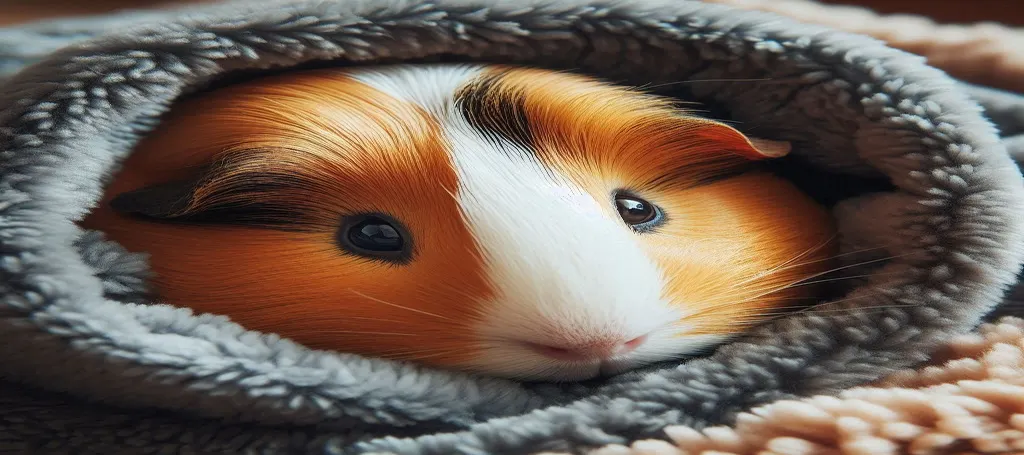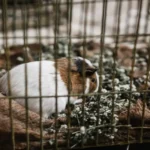Guinea pigs are sensitive to cold temperatures, especially in winter when drafts and low humidity can impact their health. Preparing a DIY guinea pig winter setup ensures your pets stay cozy and warm during colder months. In this guide, you’ll find tips on insulating cages, using fleece covers, and providing safe heating options like heat lamps or pads to create an ideal winter habitat for your Guinea pigs.
This comprehensive guide will equip you with the knowledge and practical tips to create a safe and cozy winter haven for your guinea pigs, whether they live indoors or outdoors. We’ll cover everything from understanding the risks of cold temperatures to creating a winter action plan and implementing specific strategies for both indoor and outdoor housing.
Contents
- DIY Guinea Pig Winter Setup-Proofing Your Guinea Pig’s Cage
- Additional DIY Warmth Ideas
- Safety Tips for Winter Setup
- Why Winter is a Critical Time for Guinea Pig Owners
- Be Prepared: Your Guinea Pig’s Winter Survival Guide
- Keeping Your Outdoor Guinea Pigs Cozy and Safe
- Bringing the Outdoors In: Creating a Winter Haven for Your Indoor Guinea Pigs
- Going the Extra Mile for Your Guinea Pigs This Winter
- FAQs
DIY Guinea Pig Winter Setup-Proofing Your Guinea Pig’s Cage
1. Insulating the Cage with Fleece Covers
- Materials: Fleece fabric, scissors, sewing machine (optional), or velcro strips for attachment.
- Steps:
- Measure the cage sides and cut the fleece to cover each side, leaving extra for overlapping.
- Sew or secure the edges with Velcro strips so the cover can be removed for washing.
- Drape an additional fleece layer over the top at night for extra warmth, leaving gaps for ventilation.
Benefits: Fleece is warm, moisture-wicking, and easy to wash, making it ideal for DIY cage covers.
2. Using Thick Bedding for Added Warmth
- Best Materials: Fleece, straw, hay, and absorbent liners.
- How to Set It Up:
- Layer the base of the cage with fleece liners for warmth.
- Add a thick layer of hay or straw on top to create a cozy nest for burrowing.
- Make sure to regularly replace the bedding to keep it dry and prevent odors.
Tip: Use fleece tunnels or cuddle cups to give guinea pigs snug areas to retreat into.
3. Adding Heating Pads or Heat Lamps
- DIY Heating Pad Setup:
- Use a pet-safe heating pad that stays at a low, consistent temperature.
- Place it under a corner of the cage, allowing guinea pigs to move away if they become too warm.
- Heat Lamp Tips:
- Use a low-wattage infrared heat lamp secured safely outside the cage.
- Keep the lamp at a safe distance to avoid overheating, and monitor the temperature regularly.
Note: Never use heating pads or lamps unsupervised. Make sure the power cords are inaccessible to guinea pigs to prevent chewing hazards.
Additional DIY Warmth Ideas
- DIY Cardboard Insulation
- Line the outside of the cage with thick cardboard for extra insulation, making sure not to block ventilation.
- Place the cage on a mat or rug to keep it off cold floors.
- Fleece Tents and Hiding Spots
- Use fleece to create small tents or hideouts, which can be easily added to the cage.
- Fill the hideouts with hay for added insulation.
- DIY Cuddle Blankets
- Cut fleece fabric into small blankets that guinea pigs can burrow under.
- Wash them weekly to maintain hygiene.
Safety Tips for Winter Setup
- Monitor Temperature Daily: Use a thermometer to ensure the cage stays within a comfortable range.
- Avoid Overheating: Do not cover the cage entirely, as it may restrict airflow.
- Hydration: Cold weather can reduce water intake, so ensure the water bottle doesn’t freeze and remains accessible.
- No Open Flames or High-Wattage Heaters: Only use pet-safe heating options to prevent burns and fire hazards.
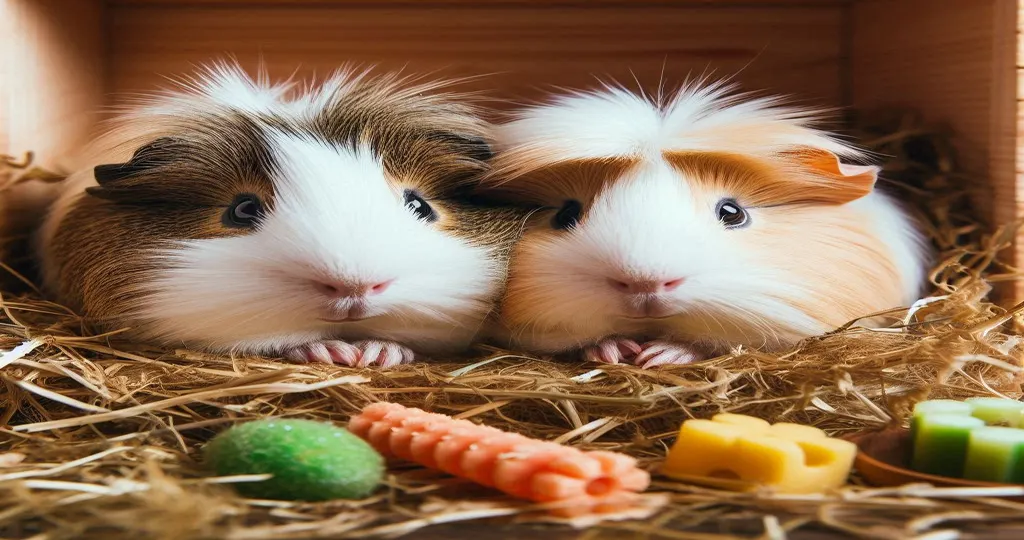
Why Winter is a Critical Time for Guinea Pig Owners
Unlike some animals that can hibernate or have thick fur coats to withstand the cold, guinea pigs rely on us to provide the warmth and protection they need to thrive. The ideal temperature range for these furry friends is between 17-23°C. When temperatures dip below 15°C, it’s time to take action to prevent potentially serious health problems.
Dangers of Cold Temperatures
- Hypothermia: The most severe risk associated with cold weather is hypothermia, a condition where the body temperature drops dangerously low. Hypothermia can be fatal if not addressed quickly. Guinea pigs are particularly susceptible to hypothermia when temperatures fall below 10°C, especially if they are wet or their hutch is damp.
- Respiratory Infections: Cold temperatures can weaken a guinea pig’s immune system, making them more prone to respiratory infections, such as pneumonia. These infections can be life-threatening, especially for young, old, or already weakened guinea pigs.
- Reduced Immunity and Other Complications: Prolonged exposure to cold can lead to a general decline in health, reduced immunity, and increased susceptibility to other illnesses. It can also exacerbate existing health problems, such as arthritis.
Recognizing the Signs
Knowing how to identify signs of cold-related distress in your guinea pigs is essential for taking prompt action. Here are some common indicators:
- Obvious Signs:
- Shivering
- Lethargy
- Loss of appetite
- Cold ears
- Subtle Signs:
- Decreased activity
- Reluctance to leave warm areas (like their hideout or bedding)
- Changes in behavior, such as becoming more withdrawn or less vocal
If you observe any of these signs, it’s crucial to consult a veterinarian immediately. Early intervention can significantly improve the chances of a full recovery.
Be Prepared: Your Guinea Pig’s Winter Survival Guide
Don’t wait for the first frost to start thinking about winter care for your guinea pigs. A proactive approach is essential for ensuring their well-being throughout the season.
Here’s how to create a comprehensive winter action plan:
- Temperature Monitoring: Invest in a thermometer to monitor both indoor and outdoor temperatures accurately. This allows you to track changes and implement necessary measures before it gets too cold. Consider 10°C as the trigger point for activating your winter plan.
- Housing Assessment: Evaluate your current housing setup. Is it well-insulated? Are there any drafts or areas where cold air can penetrate? Does the hutch need repairs or modifications? Identifying potential weaknesses in advance allows you to address them before winter sets in.
- Early Preparation: Start winterizing your guinea pig’s environment well before the coldest weather arrives, ideally when temperatures consistently fall below 10°C. This gives you ample time to make necessary changes, gather supplies, and observe how your guinea pigs react to the gradual temperature changes.
- Levels of Intervention: Depending on the severity of the cold, you’ll need to adjust your approach. For mild winters, adding extra bedding and a hutch cover might suffice. For harsher conditions, consider relocating your guinea pigs indoors or to a sheltered outbuilding.
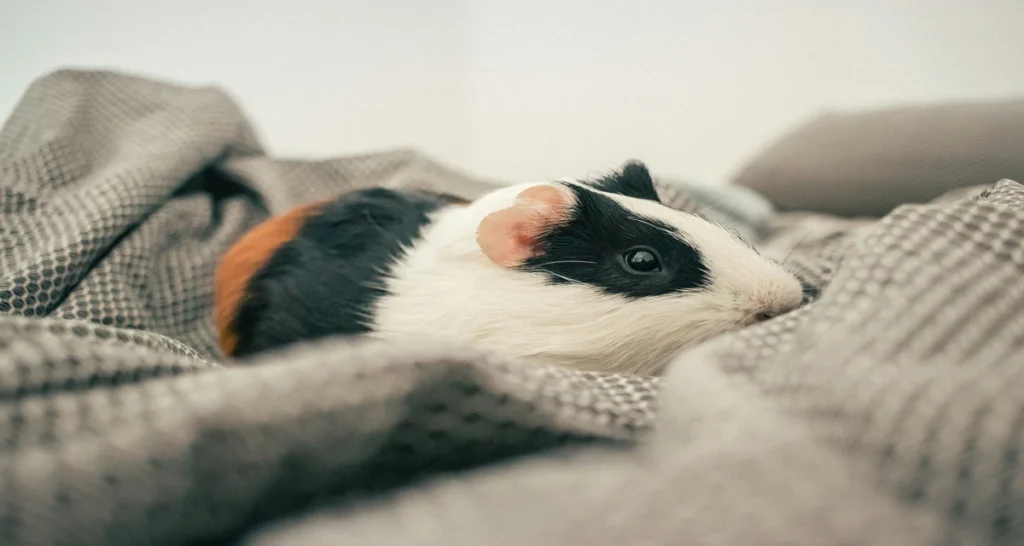
Keeping Your Outdoor Guinea Pigs Cozy and Safe
While a hutch provides essential shelter, it requires significant modifications to withstand the challenges of winter. The goal is to create a multi-layered barrier against the elements, ensuring warmth, dryness, and proper ventilation.
Multi-Layered Insulation
- External Protection: The first line of defense against wind, rain, and snow is a robust external layer.
- Hutch Covers: A well-fitted hutch cover is essential for keeping out drafts and precipitation. Look for covers specifically designed for your hutch model, ensuring they are waterproof, breathable, and securely fastened.
- Tarpaulins, Blankets, and Windbreaks: A heavy-duty tarpaulin, securely fastened, can provide an additional layer of protection over the hutch cover, especially during heavy rain or snow. Thick blankets or old duvets can also be used, but make sure they are breathable and do not restrict ventilation. Consider placing windbreaks around the hutch to minimize exposure to wind chill.
- Internal Insulation: Once you’ve addressed the exterior, focus on creating a warm and insulated interior.
- Floor Protection: A cold and damp floor can quickly chill your guinea pigs. Line the floor with a waterproof and insulating material, such as linoleum, correcx, or thick layers of newspaper. This helps retain heat and prevents moisture from seeping into the bedding.
- Wall and Roof Insulation: Insulating the interior walls and roof significantly improves heat retention and reduces drafts. Foil bubble wrap is an effective and easy-to-install option. Cut the foil to size and secure it to the interior surfaces of the hutch using staples or strong tape. Ensure the foil side faces outwards for maximum insulation.
- DIY Project Ideas: Get creative with DIY insulation projects using recycled or repurposed materials. Old cardboard boxes, bubble wrap from packaging, or even thick layers of newspaper can be used to add extra insulation to the hutch.
Bedding and Hay
- Deep Bedding Layers: Provide a deep layer of bedding material for your guinea pigs to burrow into and stay warm. Wood shavings, straw, and especially hay are excellent choices. Hay is particularly beneficial as it is a natural insulator, absorbs moisture, and provides a source of warmth and enrichment for your guinea pigs.
- The Power of Hay: Don’t underestimate the importance of hay. Make sure your guinea pigs have access to an unlimited supply of fresh, good-quality hay throughout the winter. They will use it for bedding, burrowing, and, most importantly, eating, which helps them generate body heat and stay warm.
Preventing Frozen Water
- Bottle Protection: Water bottles can freeze quickly in cold weather, depriving your guinea pigs of a vital resource. Invest in bottle covers or thermal sleeves to insulate the bottle and prevent freezing. Remember to check the bottle regularly, even with a cover, to ensure the water is flowing freely and hasn’t frozen in the nozzle.
- Water Bowl Considerations: Some guinea pigs prefer drinking from bowls. However, bowls are more prone to freezing, spills, and contamination. If you use a bowl, check it frequently to make sure it’s not frozen and the water is clean. You can also consider using a heated water bowl, specifically designed for small animals, to prevent freezing.
- Placement of Water Sources: Place water sources away from drafts and in a sheltered spot within the hutch to minimize freezing.
Relocation Options
- Sheds, Garages, and Outbuildings: If you have access to a shed, garage, or outbuilding, consider moving the hutch into this sheltered space for the winter. Ensure the structure is well-ventilated, safe from fumes or chemicals, and has some natural light. Remember that even in a sheltered space, the hutch will still require insulation and additional warmth measures.
Extra Calories and Enrichment
- Increased Hay Intake: Guinea pigs need extra calories during winter to maintain their body temperature. Provide an unlimited supply of hay to encourage eating, which helps them generate body heat.
- Nutritious Diet: Continue feeding a balanced diet with fresh vegetables, primarily those rich in Vitamin C, to support their immune system.
- Safe Exercise: Even in cold weather, guinea pigs need exercise and mental stimulation. If it’s too cold or wet for outdoor playtime, consider creating a safe and enclosed play area in a garage or shed. You can also bring your guinea pigs indoors for supervised playtime in a guinea pig-proofed room on warmer days.
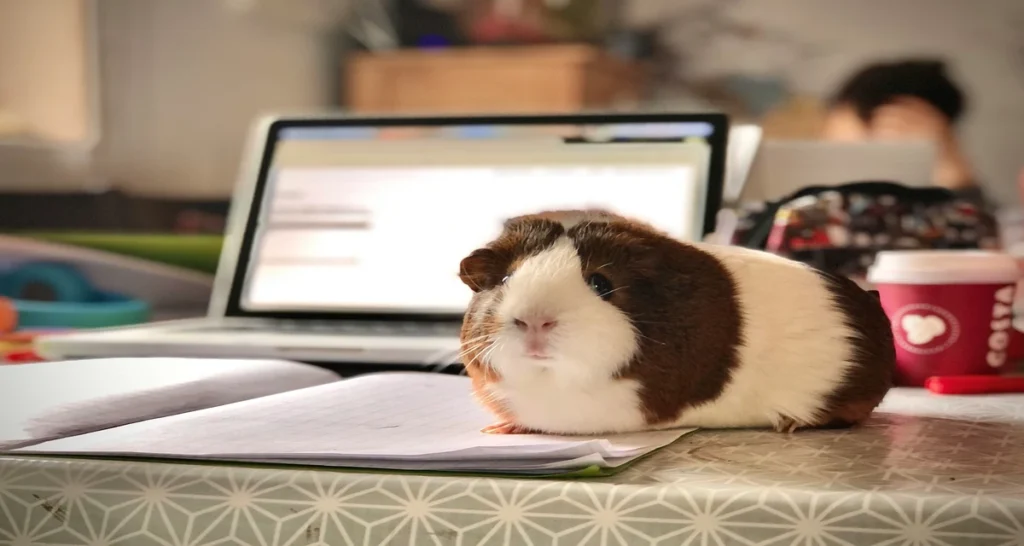
Bringing the Outdoors In: Creating a Winter Haven for Your Indoor Guinea Pigs
Indoor housing is the safest and most ethical option for guinea pigs in regions with harsh winters. It eliminates the risks associated with extreme colds and makes it easier to monitor their health and well-being.
Cage Placement is Key:
- Avoiding Drafts and Temperature Fluctuations: Position the cage away from windows, doors, and air vents to avoid sudden temperature changes and drafts, which can cause chills and respiratory problems.
- Keeping a Safe Distance from Radiators: Never place the cage too close to a radiator or other heat source. Guinea pigs can overheat quickly and may suffer burns if they come into direct contact with a hot surface.
- Elevated Position: Place the cage on a stand or table to raise it off the floor as warm air rises.
Supplemental Warmth:
- Bedding and Fleece: Provide ample bedding for your guinea pigs to burrow into. Wood shavings, shredded paper, hay, and fleece liners are all suitable options. Consider adding extra layers of bedding during colder nights. Fleece blankets and snuggle sacks provide additional warmth and comfort.
- Safe Heat Pads: Microwavable heat pads, specifically designed for small animals, are a safe and effective way to provide supplemental warmth. Ensure the pad is wrapped in a fleece cover or towel and placed under a hideout or within their bedding to prevent direct contact and burns.
- DIY Cosy Hideaways: Get creative with DIY hideaways! Cardboard boxes lined with fleece or soft blankets create warm and inviting retreats for your guinea pigs.
Indoor Enrichment:
- Importance of Exercise and Stimulation: Just because they’re indoors doesn’t mean they should be bored. Mental and physical stimulation is crucial for their well-being.
- Creating an Indoor Play Area: Designate a safe and guinea pig-proofed area in your home where they can run, explore, and play. Set up tunnels, cardboard boxes, hideaways, and safe toys to create an enriching environment.
- Foraging Activities: Engage their natural foraging instincts by hiding treats in their hay or creating foraging boxes filled with safe and stimulating materials, such as shredded paper, cardboard tubes, and willow balls.
- Social Interaction: Spend quality time with your guinea pigs. Talk to them, pet them, and offer interactive playtime. Their social needs are just as important as their physical needs, especially during indoor confinement.
Maintaining a Healthy Environment:
- Humidity Control: Indoor heating can reduce humidity, which can dry out your guinea pigs’ skin and respiratory system. A humidifier can help maintain a comfortable humidity level, especially in dry climates.
- Ventilation: Fresh air is essential, but avoid drafts directly on the cage. Ensure the room is well-ventilated without creating a chilly breeze around your guinea pigs.
- Air Quality: Guinea pigs have sensitive respiratory systems. Avoid using strong-smelling cleaners, air fresheners, or scented candles near their cage, as these can irritate their lungs.
Going the Extra Mile for Your Guinea Pigs This Winter
- Special Needs:
- Senior Guinea Pigs: Older guinea pigs are more vulnerable to cold and may need additional warmth, softer bedding, and more frequent health checks.
- Hairless Breeds: Hairless breeds, such as Skinny Pigs and Baldwins, require indoor housing year-round. They may need extra warmth measures, such as heat pads or snuggle sacks, to stay comfortable.
- Sick or Recovering Guinea Pigs: Guinea pigs recovering from illness or surgery need a warm and stable environment to aid healing. Temporary indoor housing is recommended, even if they usually live outdoors, to prevent complications.
- Ethical Considerations:
- Indoor Housing as the Safest Option: Indoor housing is the most ethical and safest option for guinea pigs during winter, especially in regions with freezing temperatures.
- Responsible Outdoor Care: If outdoor housing is unavoidable, be meticulous with insulation, temperature monitoring, and frequent health checks to ensure your guinea pigs’ safety.
- Bathing Precautions: Avoid bathing outdoor guinea pigs during cold weather. If a bath is necessary, bring them into a warm room, use lukewarm water, towel dry thoroughly, and consider using a hairdryer on a low setting to ensure they are scorched before returning them to their hutch.
FAQs
Are guinea pigs ok in winter?
Yes, guinea pigs can tolerate winter if they are kept warm and out of drafts, but they are sensitive to cold temperatures. They thrive best in a stable indoor environment, especially during colder months, as exposure to cold can make them susceptible to respiratory issues and other health risks.
How cold is too cold for a guinea pig?
Temperatures below 60°F (15°C) are too cold for guinea pigs, and anything below 50°F (10°C) can be dangerous for their health. Ideally, they should be kept in a temperature range between 65°F and 75°F (18°C-24°C) for optimal comfort and well-being.
How to keep a guinea pig warm in the winter?
To keep guinea pigs warm in winter, make sure their habitat is indoors, away from windows and drafts. Use extra bedding such as hay, fleece, or straw to insulate their cage. You can also cover part of their cage with a blanket (but keep airflow) and make sure they have a cozy area where they can snuggle up to stay warm.
Are heating pads safe for guinea pigs?
Heating pads can be safe for guinea pigs if used carefully. Opt for a low-wattage pad specifically made for small animals and place it outside one area of the cage to prevent overheating. Continuously monitor the temperature and give them the option to move away from the heat if they wish.
Do guinea pigs like heated blankets?
Heated blankets are not recommended for guinea pigs, as they can quickly overheat. Instead, provide plenty of fleece bedding or small animal-safe cozy beds that trap warmth naturally. This will allow them to stay warm without the risk of burns or overheating from an electric blanket.
Judgment
As winter approaches, let’s remember that our guinea pigs depend on us to provide the warmth and protection they need to thrive. By understanding the risks associated with cold temperatures, creating a winter action plan, and implementing specific strategies for both indoor and outdoor housing, we can ensure that our furry companions stay safe, healthy, and happy throughout the colder months. Share your winter care tips and ask any questions you may have in the comments below. Let’s work together to create a cozy and loving winter experience for all our guinea pigs.

